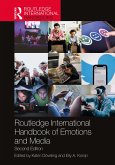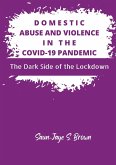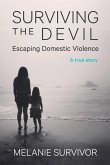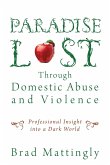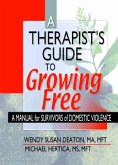The Routledge International Handbook of Domestic Violence and Abuse
Herausgeber: Devaney, John; Macy, Rebecca J.; Bradbury-Jones, Caroline
The Routledge International Handbook of Domestic Violence and Abuse
Herausgeber: Devaney, John; Macy, Rebecca J.; Bradbury-Jones, Caroline
- Gebundenes Buch
- Merkliste
- Auf die Merkliste
- Bewerten Bewerten
- Teilen
- Produkt teilen
- Produkterinnerung
- Produkterinnerung
This book makes an important contribution to the international understanding of domestic violence and shares the latest knowledge of what causes and sustains domestic violence between intimate partners, as well as the effectiveness of responses in working with adult and child victims, and those who act abusively towards their partners. Drawing upon a wide range of contemporary research from across the globe, it recognises that domestic violence is both universal, but also shaped by local cultures and contexts. Divided into seven parts: ¿ Introduction. ¿ Theoretical perspectives on domestic…mehr
Andere Kunden interessierten sich auch für
![Routledge International Handbook of Emotions and Media Routledge International Handbook of Emotions and Media]() Routledge International Handbook of Emotions and Media306,99 €
Routledge International Handbook of Emotions and Media306,99 €![Domestic Abuse and Violence in the COVID-19 Pandemic Domestic Abuse and Violence in the COVID-19 Pandemic]() Saun-Jaye S BrownDomestic Abuse and Violence in the COVID-19 Pandemic11,99 €
Saun-Jaye S BrownDomestic Abuse and Violence in the COVID-19 Pandemic11,99 €![Surviving the Devil - Escaping Domestic Violence Surviving the Devil - Escaping Domestic Violence]() Melanie SurvivorSurviving the Devil - Escaping Domestic Violence21,99 €
Melanie SurvivorSurviving the Devil - Escaping Domestic Violence21,99 €![Domestic Violence and Abuse Domestic Violence and Abuse]() Laura FinleyDomestic Violence and Abuse71,99 €
Laura FinleyDomestic Violence and Abuse71,99 €![Paradise Lost Through Domestic Abuse and Violence Paradise Lost Through Domestic Abuse and Violence]() Brad MattinglyParadise Lost Through Domestic Abuse and Violence16,99 €
Brad MattinglyParadise Lost Through Domestic Abuse and Violence16,99 €![Healing from the Trauma of Domestic Violence for Women Healing from the Trauma of Domestic Violence for Women]() Klish T. KindermanHealing from the Trauma of Domestic Violence for Women18,99 €
Klish T. KindermanHealing from the Trauma of Domestic Violence for Women18,99 €![A Therapist's Guide to Growing Free A Therapist's Guide to Growing Free]() Wendy Susan DeatonA Therapist's Guide to Growing Free39,99 €
Wendy Susan DeatonA Therapist's Guide to Growing Free39,99 €-
-
-
This book makes an important contribution to the international understanding of domestic violence and shares the latest knowledge of what causes and sustains domestic violence between intimate partners, as well as the effectiveness of responses in working with adult and child victims, and those who act abusively towards their partners. Drawing upon a wide range of contemporary research from across the globe, it recognises that domestic violence is both universal, but also shaped by local cultures and contexts. Divided into seven parts: ¿ Introduction. ¿ Theoretical perspectives on domestic violence and abuse. ¿ Domestic violence and abuse across the life-course. ¿ Manifestations of domestic violence and abuse. ¿ Responding to domestic violence and abuse. ¿ Researching domestic violence and abuse. ¿ Concluding thoughts. It will be of interest to all academics and students working in social work, allied health, sociology, criminology and gender studies as well as policy professionals looking for new approaches to the subject.
Hinweis: Dieser Artikel kann nur an eine deutsche Lieferadresse ausgeliefert werden.
Hinweis: Dieser Artikel kann nur an eine deutsche Lieferadresse ausgeliefert werden.
Produktdetails
- Produktdetails
- Verlag: Routledge
- Seitenzahl: 836
- Erscheinungstermin: 18. März 2021
- Englisch
- Abmessung: 250mm x 175mm x 49mm
- Gewicht: 1593g
- ISBN-13: 9780367334857
- ISBN-10: 0367334852
- Artikelnr.: 60604341
- Herstellerkennzeichnung
- Libri GmbH
- Europaallee 1
- 36244 Bad Hersfeld
- gpsr@libri.de
- Verlag: Routledge
- Seitenzahl: 836
- Erscheinungstermin: 18. März 2021
- Englisch
- Abmessung: 250mm x 175mm x 49mm
- Gewicht: 1593g
- ISBN-13: 9780367334857
- ISBN-10: 0367334852
- Artikelnr.: 60604341
- Herstellerkennzeichnung
- Libri GmbH
- Europaallee 1
- 36244 Bad Hersfeld
- gpsr@libri.de
John Devaney is Professor and Centenary Chair of Social Work at the University of Edinburgh, United Kingdom. Caroline Bradbury-Jones is Professor of Gender-Based Violence and Health at the University of Birmingham, United Kingdom. Rebecca J. Macy is Professor and Associate Dean for Research and Faculty Development at the University of Northern Carolina at Chapel Hill School of Social Work, USA. Carolina Øverlien is a Research leader at Norwegian Center for Violence and Traumatic Stress Studies (NKVTS) in Oslo, Norway, and Professor at Stockholm University, Sweden. Stephanie Holt is Associate Professor in the School of Social Work and Social Policy, Trinity College Dublin, Republic of Ireland.
Part 1: Introduction. 1 Introduction. Part 2: Theoretical Perspectives on
Domestic Violence and Abuse. 2 Domestic violence and abuse through a
feminist lens. 3 Psychology and domestic violence against womxn. 4 Domestic
violence and abuse through a sociological lens. 5 Domestic violence and
abuse through a criminological lens. 6 Domestic violence through a Human
Rights lens. 7 Tackling domestic violence and abuse using a rights-oriented
public health lens. 8 Domestic violence and abuse through a psychological
lens. Part 3: Domestic Violence and Abuse Across the Life-course. 9 The
impact of domestic violence and abuse on infant mental health. 10 Domestic
violence and the impact on children. 11 Preventive socialisation of
intimate partner violence through the analysis of family interactions and
previous intimate relationships. 12 Youth intimate partner violence. 13 The
middle years - a neglected population regarding domestic violence and
abuse? 14 Intimate Partner Violence: Transforming the response to older
victim-survivors in later life. Part 4: Manifestations of Domestic Violence
and Abuse. 15 Sexual violence within intimate relationships. 16 Domestic
violence and abuse within male same-sex relationships. 17 Domestic violence
and abuse within female same-sex relationships. 18 Domestic violence and
abuse when survivors identify as trans or non-binary. 19 Economic abuse
within intimate relationships. 20 Domestic violence and disability in India
explored in relation to the sustainable development goals. 21 Domestic
violence and animal abuse. 22 Transnational marriage abandonment: A new
form of domestic violence and abuse in transnational spaces. 23
Technology-assisted abuse within intimate relationships. 24 Intimate
partner homicide. 25 Coercive control. 26 Murder in the Family: Why culture
is an insufficient explanation for 'honour'-based violence. 27 Intimate
partner violence against women in forced migration. Part 5: Responding to
Domestic Violence and Abuse. 28 International review of the literature on
risk assessment and management of domestic violence and abuse. 29
Interventions for children and young people who have experienced domestic
violence and abuse. 30 Mothering in the context of domestic violence. 31
Fathering in the context of domestic violence and abuse. 32 Adolescent
intimate partner violence prevention & intervention: a developmental,
intersectional perspective. 33 Community-based safety partnerships to
reduce gender-based violence in Uganda: The Anti-Domestic Violence and
Abuse Center (ADOVIC) approach. 34 Healthcare-based violence against women
strategies to address the problem in Argentina. 35 Domestic violence
survivors' emotional and mental health. 36 Housing strategies for
addressing domestic violence and abuse. 37 Economic empowerment in the
context of domestic violence and abuse. 38 Gender justice advocates and the
making of the Domestic Abuse (Scotland) Act 2018. 39 Trauma-informed and
oppression-sensitive intervention for those who engage in intimate partner
violence. Part 6: Researching Domestic Violence and Abuse. 40 Listening to
less-heard voices: methodological approaches, considerations and challenges
when researching domestic violence and abuse with vulnerable and
marginalised women. 41 Creative methodologies: using digital stories to
embed the voices of children within programs for men who use domestic
violence. 42 Qualitative interviews with children and adolescents who have
experienced domestic violence and abuse. 43 Domestic Homicide Review
processes as a method of learning. 44 Interventions to prevent or reduce
adolescent dating violence: methodological considerations in
randomized-controlled trials. 45 Evaluating group based programmes for
individuals who use violence and abuse in their intimate relationships. 46
Community-based research in the domestic violence context. 47 Mixed methods
in the context of quasi-experimental research designs. 48 Quantitative
methods for researching domestic violence and abuse. 49 Extending women's
voice through innovative methods: lessons from struggles for democracy in
Hong Kong. Part 7: Concluding Thoughts. 50 Conclusion.
Domestic Violence and Abuse. 2 Domestic violence and abuse through a
feminist lens. 3 Psychology and domestic violence against womxn. 4 Domestic
violence and abuse through a sociological lens. 5 Domestic violence and
abuse through a criminological lens. 6 Domestic violence through a Human
Rights lens. 7 Tackling domestic violence and abuse using a rights-oriented
public health lens. 8 Domestic violence and abuse through a psychological
lens. Part 3: Domestic Violence and Abuse Across the Life-course. 9 The
impact of domestic violence and abuse on infant mental health. 10 Domestic
violence and the impact on children. 11 Preventive socialisation of
intimate partner violence through the analysis of family interactions and
previous intimate relationships. 12 Youth intimate partner violence. 13 The
middle years - a neglected population regarding domestic violence and
abuse? 14 Intimate Partner Violence: Transforming the response to older
victim-survivors in later life. Part 4: Manifestations of Domestic Violence
and Abuse. 15 Sexual violence within intimate relationships. 16 Domestic
violence and abuse within male same-sex relationships. 17 Domestic violence
and abuse within female same-sex relationships. 18 Domestic violence and
abuse when survivors identify as trans or non-binary. 19 Economic abuse
within intimate relationships. 20 Domestic violence and disability in India
explored in relation to the sustainable development goals. 21 Domestic
violence and animal abuse. 22 Transnational marriage abandonment: A new
form of domestic violence and abuse in transnational spaces. 23
Technology-assisted abuse within intimate relationships. 24 Intimate
partner homicide. 25 Coercive control. 26 Murder in the Family: Why culture
is an insufficient explanation for 'honour'-based violence. 27 Intimate
partner violence against women in forced migration. Part 5: Responding to
Domestic Violence and Abuse. 28 International review of the literature on
risk assessment and management of domestic violence and abuse. 29
Interventions for children and young people who have experienced domestic
violence and abuse. 30 Mothering in the context of domestic violence. 31
Fathering in the context of domestic violence and abuse. 32 Adolescent
intimate partner violence prevention & intervention: a developmental,
intersectional perspective. 33 Community-based safety partnerships to
reduce gender-based violence in Uganda: The Anti-Domestic Violence and
Abuse Center (ADOVIC) approach. 34 Healthcare-based violence against women
strategies to address the problem in Argentina. 35 Domestic violence
survivors' emotional and mental health. 36 Housing strategies for
addressing domestic violence and abuse. 37 Economic empowerment in the
context of domestic violence and abuse. 38 Gender justice advocates and the
making of the Domestic Abuse (Scotland) Act 2018. 39 Trauma-informed and
oppression-sensitive intervention for those who engage in intimate partner
violence. Part 6: Researching Domestic Violence and Abuse. 40 Listening to
less-heard voices: methodological approaches, considerations and challenges
when researching domestic violence and abuse with vulnerable and
marginalised women. 41 Creative methodologies: using digital stories to
embed the voices of children within programs for men who use domestic
violence. 42 Qualitative interviews with children and adolescents who have
experienced domestic violence and abuse. 43 Domestic Homicide Review
processes as a method of learning. 44 Interventions to prevent or reduce
adolescent dating violence: methodological considerations in
randomized-controlled trials. 45 Evaluating group based programmes for
individuals who use violence and abuse in their intimate relationships. 46
Community-based research in the domestic violence context. 47 Mixed methods
in the context of quasi-experimental research designs. 48 Quantitative
methods for researching domestic violence and abuse. 49 Extending women's
voice through innovative methods: lessons from struggles for democracy in
Hong Kong. Part 7: Concluding Thoughts. 50 Conclusion.
Part 1: Introduction. 1 Introduction. Part 2: Theoretical Perspectives on
Domestic Violence and Abuse. 2 Domestic violence and abuse through a
feminist lens. 3 Psychology and domestic violence against womxn. 4 Domestic
violence and abuse through a sociological lens. 5 Domestic violence and
abuse through a criminological lens. 6 Domestic violence through a Human
Rights lens. 7 Tackling domestic violence and abuse using a rights-oriented
public health lens. 8 Domestic violence and abuse through a psychological
lens. Part 3: Domestic Violence and Abuse Across the Life-course. 9 The
impact of domestic violence and abuse on infant mental health. 10 Domestic
violence and the impact on children. 11 Preventive socialisation of
intimate partner violence through the analysis of family interactions and
previous intimate relationships. 12 Youth intimate partner violence. 13 The
middle years - a neglected population regarding domestic violence and
abuse? 14 Intimate Partner Violence: Transforming the response to older
victim-survivors in later life. Part 4: Manifestations of Domestic Violence
and Abuse. 15 Sexual violence within intimate relationships. 16 Domestic
violence and abuse within male same-sex relationships. 17 Domestic violence
and abuse within female same-sex relationships. 18 Domestic violence and
abuse when survivors identify as trans or non-binary. 19 Economic abuse
within intimate relationships. 20 Domestic violence and disability in India
explored in relation to the sustainable development goals. 21 Domestic
violence and animal abuse. 22 Transnational marriage abandonment: A new
form of domestic violence and abuse in transnational spaces. 23
Technology-assisted abuse within intimate relationships. 24 Intimate
partner homicide. 25 Coercive control. 26 Murder in the Family: Why culture
is an insufficient explanation for 'honour'-based violence. 27 Intimate
partner violence against women in forced migration. Part 5: Responding to
Domestic Violence and Abuse. 28 International review of the literature on
risk assessment and management of domestic violence and abuse. 29
Interventions for children and young people who have experienced domestic
violence and abuse. 30 Mothering in the context of domestic violence. 31
Fathering in the context of domestic violence and abuse. 32 Adolescent
intimate partner violence prevention & intervention: a developmental,
intersectional perspective. 33 Community-based safety partnerships to
reduce gender-based violence in Uganda: The Anti-Domestic Violence and
Abuse Center (ADOVIC) approach. 34 Healthcare-based violence against women
strategies to address the problem in Argentina. 35 Domestic violence
survivors' emotional and mental health. 36 Housing strategies for
addressing domestic violence and abuse. 37 Economic empowerment in the
context of domestic violence and abuse. 38 Gender justice advocates and the
making of the Domestic Abuse (Scotland) Act 2018. 39 Trauma-informed and
oppression-sensitive intervention for those who engage in intimate partner
violence. Part 6: Researching Domestic Violence and Abuse. 40 Listening to
less-heard voices: methodological approaches, considerations and challenges
when researching domestic violence and abuse with vulnerable and
marginalised women. 41 Creative methodologies: using digital stories to
embed the voices of children within programs for men who use domestic
violence. 42 Qualitative interviews with children and adolescents who have
experienced domestic violence and abuse. 43 Domestic Homicide Review
processes as a method of learning. 44 Interventions to prevent or reduce
adolescent dating violence: methodological considerations in
randomized-controlled trials. 45 Evaluating group based programmes for
individuals who use violence and abuse in their intimate relationships. 46
Community-based research in the domestic violence context. 47 Mixed methods
in the context of quasi-experimental research designs. 48 Quantitative
methods for researching domestic violence and abuse. 49 Extending women's
voice through innovative methods: lessons from struggles for democracy in
Hong Kong. Part 7: Concluding Thoughts. 50 Conclusion.
Domestic Violence and Abuse. 2 Domestic violence and abuse through a
feminist lens. 3 Psychology and domestic violence against womxn. 4 Domestic
violence and abuse through a sociological lens. 5 Domestic violence and
abuse through a criminological lens. 6 Domestic violence through a Human
Rights lens. 7 Tackling domestic violence and abuse using a rights-oriented
public health lens. 8 Domestic violence and abuse through a psychological
lens. Part 3: Domestic Violence and Abuse Across the Life-course. 9 The
impact of domestic violence and abuse on infant mental health. 10 Domestic
violence and the impact on children. 11 Preventive socialisation of
intimate partner violence through the analysis of family interactions and
previous intimate relationships. 12 Youth intimate partner violence. 13 The
middle years - a neglected population regarding domestic violence and
abuse? 14 Intimate Partner Violence: Transforming the response to older
victim-survivors in later life. Part 4: Manifestations of Domestic Violence
and Abuse. 15 Sexual violence within intimate relationships. 16 Domestic
violence and abuse within male same-sex relationships. 17 Domestic violence
and abuse within female same-sex relationships. 18 Domestic violence and
abuse when survivors identify as trans or non-binary. 19 Economic abuse
within intimate relationships. 20 Domestic violence and disability in India
explored in relation to the sustainable development goals. 21 Domestic
violence and animal abuse. 22 Transnational marriage abandonment: A new
form of domestic violence and abuse in transnational spaces. 23
Technology-assisted abuse within intimate relationships. 24 Intimate
partner homicide. 25 Coercive control. 26 Murder in the Family: Why culture
is an insufficient explanation for 'honour'-based violence. 27 Intimate
partner violence against women in forced migration. Part 5: Responding to
Domestic Violence and Abuse. 28 International review of the literature on
risk assessment and management of domestic violence and abuse. 29
Interventions for children and young people who have experienced domestic
violence and abuse. 30 Mothering in the context of domestic violence. 31
Fathering in the context of domestic violence and abuse. 32 Adolescent
intimate partner violence prevention & intervention: a developmental,
intersectional perspective. 33 Community-based safety partnerships to
reduce gender-based violence in Uganda: The Anti-Domestic Violence and
Abuse Center (ADOVIC) approach. 34 Healthcare-based violence against women
strategies to address the problem in Argentina. 35 Domestic violence
survivors' emotional and mental health. 36 Housing strategies for
addressing domestic violence and abuse. 37 Economic empowerment in the
context of domestic violence and abuse. 38 Gender justice advocates and the
making of the Domestic Abuse (Scotland) Act 2018. 39 Trauma-informed and
oppression-sensitive intervention for those who engage in intimate partner
violence. Part 6: Researching Domestic Violence and Abuse. 40 Listening to
less-heard voices: methodological approaches, considerations and challenges
when researching domestic violence and abuse with vulnerable and
marginalised women. 41 Creative methodologies: using digital stories to
embed the voices of children within programs for men who use domestic
violence. 42 Qualitative interviews with children and adolescents who have
experienced domestic violence and abuse. 43 Domestic Homicide Review
processes as a method of learning. 44 Interventions to prevent or reduce
adolescent dating violence: methodological considerations in
randomized-controlled trials. 45 Evaluating group based programmes for
individuals who use violence and abuse in their intimate relationships. 46
Community-based research in the domestic violence context. 47 Mixed methods
in the context of quasi-experimental research designs. 48 Quantitative
methods for researching domestic violence and abuse. 49 Extending women's
voice through innovative methods: lessons from struggles for democracy in
Hong Kong. Part 7: Concluding Thoughts. 50 Conclusion.


